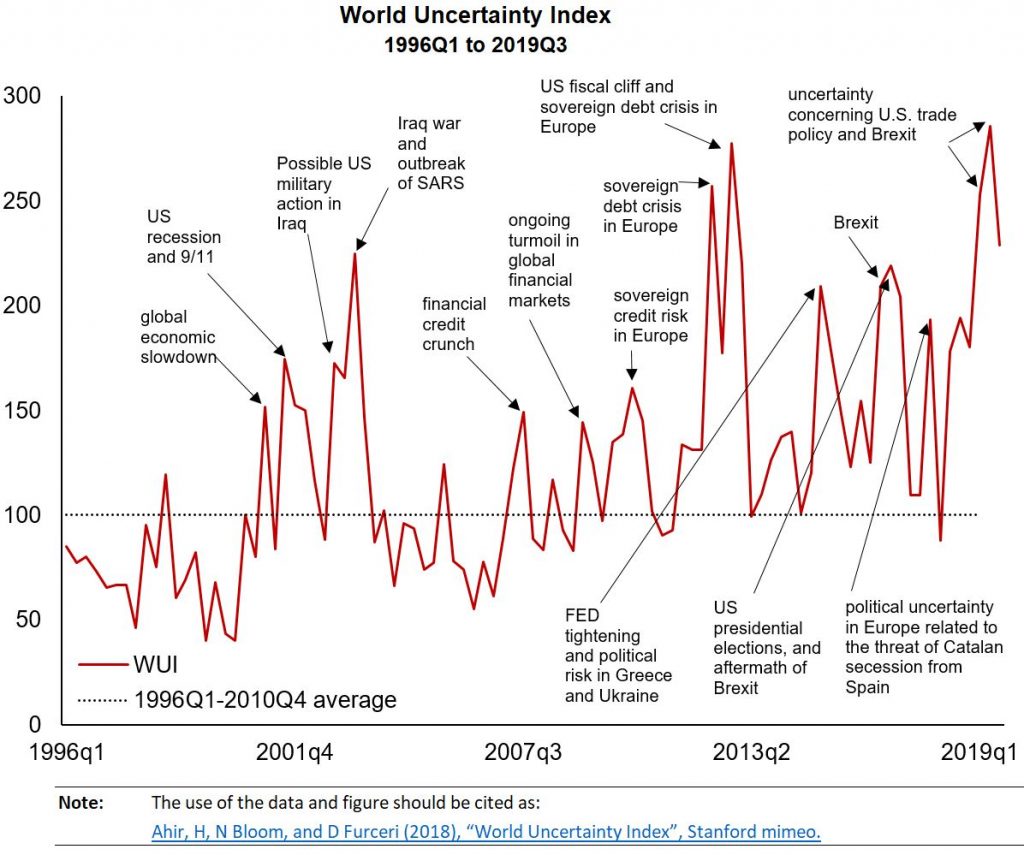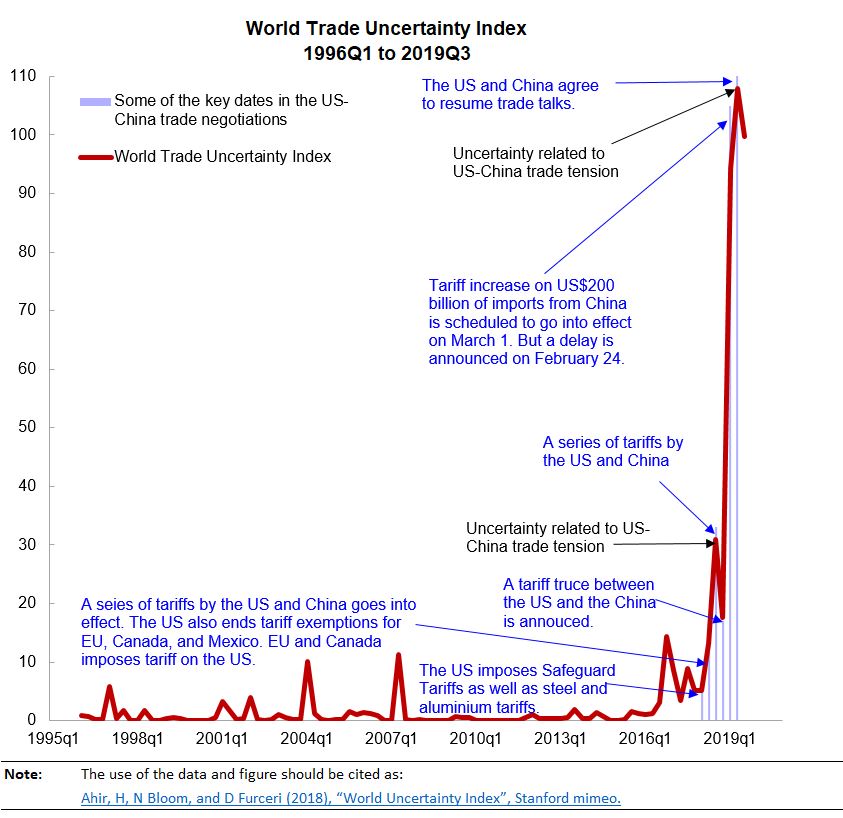Monday, September 30, 2019
Tracking uncertainty across the globe
Below is the latest update of the World Uncertainty Index (figure 1) and World Trade Uncertainty Index (figure 2). These indexes are constructed by Hites Ahir (IMF), Nick Bloom (Stanford University) and Davide Furceri (IMF).
To read how the index is constructed, see the paper here and also see the dataset here. The dataset includes the aggregate index (the index at the global level, by income group, and by region), as well as the country specific index (143 countries) from 1996Q1 to 2019Q3. It also contains a beta version of the historical index for about 80 countries starting from the 1950s.
See the coverage of the index in the press: Bloomberg, The Economist, Financial Times, Reuters, and Wall Street Journal.
Figure 1.
Figure 2.
Below is the latest update of the World Uncertainty Index (figure 1) and World Trade Uncertainty Index (figure 2). These indexes are constructed by Hites Ahir (IMF), Nick Bloom (Stanford University) and Davide Furceri (IMF).
To read how the index is constructed, see the paper here and also see the dataset here. The dataset includes the aggregate index (the index at the global level, by income group, and by region),
Posted by at 5:00 AM
Labels: Uncategorized
Saturday, September 28, 2019
The Phillips Curve: a Relation between Real Exchange Rate Growth and Unemployment
From a working paper by François Geerolf:
“The negative relationship between inflation and unemployment (also known as the Phillips curve) has been repeatedly challenged in the last decades: missing inflation in 2013-2019, missing deflation in 2007-2010, missing inflation in the late 1990s, stagflation in the 1970s, contrasting with always strong regional Phillips curves. Using data from multiple sources, this paper helps to solve many empirical puzzles by distinguishing between fixed and flexible exchange rate regimes: in fixed exchange rate regimes, inflation is negatively correlated with unemployment but this relationship does not hold in flexible regimes. By contrast, there is a negative correlation between real exchange rate appreciation and unemployment, which remains consistent in both fixed and flexible regimes. These crucial observations have important implications for identifying the source of business cycle fluctuations, for normative analysis, and imply a significant departure from rational-expectation-based solutions to Phillips curve puzzles.”
From a working paper by François Geerolf:
“The negative relationship between inflation and unemployment (also known as the Phillips curve) has been repeatedly challenged in the last decades: missing inflation in 2013-2019, missing deflation in 2007-2010, missing inflation in the late 1990s, stagflation in the 1970s, contrasting with always strong regional Phillips curves. Using data from multiple sources, this paper helps to solve many empirical puzzles by distinguishing between fixed and flexible exchange rate regimes: in fixed exchange rate regimes,
Posted by at 1:55 PM
Labels: Macro Demystified
Private Sector Job Creation in MENA: Prioritizing the Reform Agenda
From an IMF working paper by Benedicte Baduel; Carolin Geginat; and Gaëlle Pierre:
“This paper examines the extent to which firms in selected MENA countries reported being constrained by the business environment around the time of the Arab Spring and the extent to which these constraints affected their employment performance. The results suggest that small firms in MENA faced more structural constraints than similar firms in other regions. We also find that MENA firms’ weaker job creation can be explained in great part by the macroeconomic environment and structural constraints. Low GDP growth, falling external competitiveness, corruption, lack of access to finance and poor access to electricity are found to explain a significant part of the lack of employment growth in MENA firms compared to their peers.”
From an IMF working paper by Benedicte Baduel; Carolin Geginat; and Gaëlle Pierre:
“This paper examines the extent to which firms in selected MENA countries reported being constrained by the business environment around the time of the Arab Spring and the extent to which these constraints affected their employment performance. The results suggest that small firms in MENA faced more structural constraints than similar firms in other regions. We also find that MENA firms’ weaker job creation can be explained in great part by the macroeconomic environment and structural constraints.
Posted by at 1:50 PM
Labels: Inclusive Growth
Beyond Growth: Towards A New Economic Approach
From the OECD:
“Launched in May 2015, OECD Secretary-General Angel Gurría’s ‘21 for 21’ proposal called for consolidation and further transformation of the OECD by ‘redefining the growth narrative to put the well-being of people at the centre of our efforts.’
To contribute to this debate, in 2018 the Secretary-General commissioned an Advisory Group on a New Growth Narrative to examine how economic, social and environmental considerations could be integrated in a coherent approach. Acting in a personal capacity, the Advisory Group comprises Andy Haldane, Michael Jacobs, Nora Lustig, Mariana Mazzucato, Robert Skidelsky, Dennis Snower and Roberto Unger.1 The Group has sought to bring together in a single, short and readable document the various strands of new economic thinking curated over recent years by the New Approaches to Economic Challenges (NAEC) initiative. Beyond Growth: Towards a New Economic Approach is their draft report.
The report was written and coordinated by Michael Jacobs, with research assistance by Merve Sancak at the Sheffield Political Economy Research Institute. The project has been overseen by the OECD Chief of Staff and Sherpa, Gabriela Ramos, who has responsibility for NAEC in the OECD Secretariat, with the support of William Hynes.
The report attempts to synthesise a wide range of reflection on new ways of thinking about economic policymaking. It encompasses a new set of goals and measures of economic progress; new frameworks of economic analysis; and new approaches to policy.
While reactions from OECD members are strongly welcomed, this is not an OECD report requiring approval. Nor is it exhaustive in the content covered. Focusing on the challenges facing OECD countries, it builds on New Approaches to Economic Challenges: Towards a New Narrative presented at OECD Week in 2017 and Elements of a New Growth Narrative (SG/NAEC(2018)1) discussed at the NAEC Group meeting in September 2018 marking 10 years after the collapse of Lehman Brothers.
The objective of this draft document is to receive feedback and comments from the different OECD Policy Committees and Members that will participate in the NAEC Group meeting of 17-18 September, and to continue the dialogue with NAEC partners and thinkers outside the OECD.
The opinions expressed and the arguments employed herein do not necessarily reflect the official views of OECD member countries, nor any institution with which the contributors may be affiliated.”
Continue reading here.
From the OECD:
“Launched in May 2015, OECD Secretary-General Angel Gurría’s ‘21 for 21’ proposal called for consolidation and further transformation of the OECD by ‘redefining the growth narrative to put the well-being of people at the centre of our efforts.’
To contribute to this debate, in 2018 the Secretary-General commissioned an Advisory Group on a New Growth Narrative to examine how economic, social and environmental considerations could be integrated in a coherent approach.
Posted by at 1:47 PM
Labels: Inclusive Growth
Friday, September 27, 2019
Housing View – September 27, 2019
On cross-country:
- Assessing House Prices: Insights from “Houselev”, a Dataset of Price Level Estimates – European Commission
- Rent control will make housing shortages worse – Economist
On the US:
- Should People Profit From Housing? Bernie Sanders Says Yes, and No – New York Times
- Bernie Sanders’s housing-for-all plan, explained – Vox
- Mortgage Investors Need Not Fear Supply Surge From New Housing – Bloomberg
- How Telecommuting Has Changed Real Estate – New York Times
- Did California Just Abolish Single-Family Zoning? – Reason
- Why the wealth inequality debate should be a housing debate – American Enterprise Institute
- Returns to owner-occupied Housing and Wealth Inequality – UCLA
- Why Are Small and Medium Multifamily Properties So Inexpensive? – University of Tennessee
- Housing Markets Turning Ugly In 2019 – Forbes
- The New Campus Housing Bubble – Forbes
- Statewide Rent Control Will Make California’s Housing Crisis Even Worse – Hoover Institution
- Real Housing Prices Stabilizing … or Falling – Econbrowser
On other countries:
- [Cambodia] Cambodia’s housing market is oversupplied – Global Property Guide
- [Finland] Finland’s housing market remains weak – Global Property Guide
- [Japan] Why Housing Is More Affordable In Tokyo – Milken Institute
- [Sweden] Sweden’s house prices have stalled – Global Property Guide
- [United Kingdom] More than 8 million people in England living in unsuitable housing – Guardian
On cross-country:
- Assessing House Prices: Insights from “Houselev”, a Dataset of Price Level Estimates – European Commission
- Rent control will make housing shortages worse – Economist
On the US:
- Should People Profit From Housing? Bernie Sanders Says Yes, and No – New York Times
- Bernie Sanders’s housing-for-all plan, explained – Vox
- Mortgage Investors Need Not Fear Supply Surge From New Housing – Bloomberg
- How Telecommuting Has Changed Real Estate – New York Times
- Did California Just Abolish Single-Family Zoning?
Posted by at 5:00 AM
Labels: Global Housing Watch
Subscribe to: Posts





